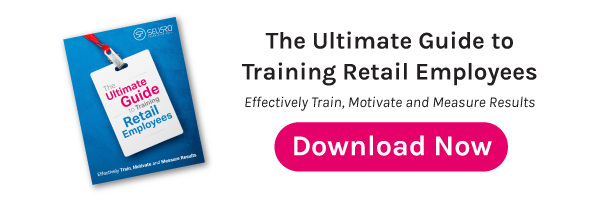Retail learning and development teams often develop KPIs based on outdated methodologies that lead to an unbalanced look at how retail employees are performing. The entire point of training is to give retail associates the tools they need to succeed, but measuring that success is not always straightforward.
Why Are Retail Training KPIs Flawed?
Total Fixation on the Wrong Metrics
Metric Fixation, a phrase coined by Professor Jerry Muller in his book The Tyranny of Metrics, focuses on an inability to look past hard data. By emphasizing statistical metrics TOO much, we overlook the effectiveness in a more holistic way. L&D departments and retail trainers often fall into the following traps when laying out their annual metrics, in an effort to concretely demonstrate their contributions.
- Course Completion Rate - An L&D department reports to management that 100% of retail employees completed a training seminar. While the number looks good on paper, it doesn't show how effective the training was. According to Retail Touchpoints: "As many as 27% (of retail employees) say their training isn’t effective because it is too boring and not engaging enough."
- Number of trained employees - Even less logical than course completion rate, the number of employees trained, even as a percentage of total employees, has no bearing on their knowledge retention or application.
- Assessment Pass Rate - If the test can be cheated, rest assured it will. If there’s no practical evaluation, this can be a red herring.
- Total Sales - Even if retail associates feel their training was practical, measuring overall sales at a retail location doesn't tell the entire story. Macro environment threats such as a trend of higher online purchasing and a retail landscape devastated by the COVID-19 pandemic shouldn't fall on employees' shoulders.
- Customer Reviews/Satisfaction Scores - Giving retail associates goals is a good thing, but not when those goals aren't achievable, or management forces them with little motivation. If too much emphasis is placed on positive customer reviews, for example, employees may ask friends or family to write them -- even if they haven't been to the store. In this case, little to no employee improvement is encouraged.
GET THE GUIDE: Effectively Train, Motivate and Measure Results
How Retailers Should Measure Training - Effectiveness
The Kirkpatrick Evaluation Model
University of Wisconsin professor Donald Kirkpatrick, Ph.D., created a measurement model -- The Kirkpatrick Evaluation Model -- that many retail trainers use today. There are four key points in the model: Reaction, Learning, Behavior, and Results.
1) Training Reaction
How well did the employees react to the training? Retailers can measure this by asking employees about the effectiveness -- if they liked it, how effective they felt it was, and what should change going forward. When retail employees react positively to training, it becomes more effective.
Download - The Ultimate Guide to Training Retail Employees
2) Learning
Did the employees take something away from the training? By implementing post-training tests, quizzes, and feedback, retailers can fine-tune training modules to be more effective. Using technology and tactics that resonate with (often young) retail employees also improves learning outcomes. Including gamification and utilizing mobile-based training can increase employee information retention by 17%. (Learn more on this in our post: Gamification Tips for Better Retail Employee Engagement)
3) Post-training Behavior
How are employees feeling and behaving post-training? Utilizing manager feedback, on-the-job observation, and measurement against a set of holistic KPIs will allow retail trainers to see how training goes in real-time. This way, they can tweak training practices if something isn't working.
4) Results
Did the training work? Holistically measuring employee retention, customer reviews, increased sales, and higher productivity can give a retailer a much better handle on the training's effectiveness. But this needs to be coupled with employee feedback on training. When employees feel engaged and confident, they're more apt to create a more welcoming shopping experience for customers.
Effective L&D Measurement Practices for Retail Employees
Instead of focusing on traditional measurements, retail learning and development departments should focus on how effectively its employees absorb the information. Engaging and motivating retail employees through effective training are things we do very well. We keep employees inspired with higher rates of retention through our mobile-first apps that allow retail trainers to:
- Engage employees with surveys and feedback
- Train with a twist with mobile, microlearning courses that include gamification and rewards
- Cultivate confident employees with training and sales resources at their fingertips on their mobile phones
Reach out to our team to learn how to boost your L&D program and wow your leadership with the measures that really matter.
Additional Resources
Where Retailers Go Wrong in Learning and Development
mLearning Courses Your Retail Employees Need Now as Stores Reopen
Gamification Tips for Better Retail Employee Engagement



